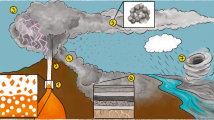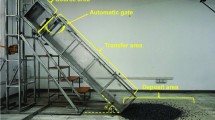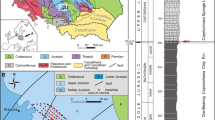Abstract
We present multi-parameter geophysical measurements of rainfall-induced lahars at Semeru Volcano, East Java, using two observation sites 510 m apart, 11.5 km from the summit. Our study site in the Curah Lengkong channel is composed of a 30-m wide box-valley, with a base of gravel and lava bedrock, representing an ideal geometry for high density measurements of active lahars. Instrumentation included pore-pressure sensors (stage), a broad-band seismograph (arrival times, vibrational energy, and turbulence), video footage, and direct bucket sampling. A total of 8 rainfall-induced lahars were recorded, with durations of 1–3 h, heights 0.5–2 m, and peak velocities 3–6 m/s. Flow types ranged from dilute to dense hyperconcentrated flows. These recorded flows were commonly composed of partly coalesced, discrete and unsteady gravity current packets, represented by multiple peaks within each lahar. These packets most likely originate from multiple lahar sources, and can be traced between instrument sites. Those with the highest concentrations and greatest wetted areas were often located mid-lahar at our measured reach, accelerating towards the flow front. As these lahars travel downstream, the individual packets thus coalesce and the flow develops a more organised structure. Observations of different degrees of coalescence between these discrete flow packets illustrate that a single mature debris flow may have formed from multiple dynamically independent lahars, each with different origins.





Similar content being viewed by others
References
Arattano M, Moia F (1999) Monitoring the propagation of a debris flow along a torrent. Hydrol Sci J 44:811–823
Arattano M, Marchi L (2008) Systems and sensors for debris-flow monitoring and warning. Sensors 8:2436–2452
Beverage J, Culbertson J (1964) Hyperconcentrations of suspended sediment. Am Soc Civ Eng 90:117–126
Carrivick JL, Manville V, Cronin SJ (2008) A fluid dynamics approach to modelling the 18th March 2007 lahar at Mt. Ruapehu, New Zealand. Bull Volcanol 71:153–169. doi:10.1007/s00445-008-0213-2
Cole S, Cronin S, Sherburn S, Manville V (2009) Seismic signals of snow- slurry lahars in motion: 25 Sept. 2007, Mt. Ruapehu, N.Z. Geophys Res Lett 36:L09405. doi:10.1029/2009GL038030
Coussot P, Meunier M (1996) Recognition, classification and mechanical description of debris flows. Earth Sci Rev 40:209–227
Cronin SJ, Neall VE, Lecointre JA, Palmer AS (1997) Changes in Whangaehu River lahar characteristics during the 1995 eruption sequence, Ruapehu volcano, N.Z. J Volcanol Geotherm Res 76:47–61
Cronin SJ, Neall VE, Lecointre JA, Palmer AS (1999) Dynamic interactions between lahars and stream flow: a case study from Ruapehu volcano, N.Z. Geol Soc Am Bull 111:28–38
Doyle EE, Cronin SJ, Cole SE, Thouret J-C (2009) The challenges of incorporating temporal and spatial changes into numerical models of lahars. In: Proceedings of the 18th World International Congress on Modelling and Simulation, Modelling and Simulation Society of Australia and New Zealand, Cairns, 13–17 July 2009
Dumaisnil C, Thouret J-C, Chambon G, Doyle EE, Cronin SJ (2010) Distinctive hydraulic characteristics and a frictional model apply to lahar flows at Semeru volcano (Indonesia). Earth Surf Proc Landf. doi:10.1002/esp.2003
Fagents SA, Baloga SM (2006) Toward a model for the bulking and debulking of lahars. J Geophys Res 111:B10201. doi:10.1029/2005JB003986
Huang CJ, Shieh CL, Yin HY (2004) Laboratory study of the underground sound generated by debris flows. J Geophys Res 109:F01008. doi:10.1029/2003JF000048
Huang C-J, Yin H-Y, Chen C-Y, Yeh C-H, Wang C-L (2007) Ground vibrations produced by rock motions and debris flows. J Geophys Res 112:F02014. doi:10.1029/2005JF000437
Hürlimann M, Rickenmann D, Graf C (2003) Field and monitoring data of debris-flow events in the Swiss Alps. Can Geotech J 40:161–175
Iverson RM (1997) The physics of debris flows. Rev Geophys 35:245–296
Iverson RM, Denlinger RP (2001) Flow of variably fluidized granular masses across three-dimensional terrain. 1. Coulomb mixture theory. J Geophys Res 106:537–552
Iverson RM, Reid ME, LaHusen RG (1997) Debris-flow mobilization from landslides. Ann Rev Earth Planet Sci 25:85–138
Lavigne S, Suwa H (2004) Contrasts between debris flows, hyperconcentrated flows and stream flows at a channel of Mt. Semeru, East Java, Indonesia. Geomorphology 61:41–58
Lavigne F, Thouret J-C, Voight B, Young K, La Husen R, Marso J, Suwa H, Sumaryono A, Sayudi DS, Dejean M (2000) Instrumental lahar monitoring at Merapi volcano. J Volcanol Geotherm Res 100:457–478
Lavigne F, Tirel A, Le Froch D, Veyrat-Charvillon S (2003) A real-time assessment of lahar dynamics and sediment load based on video-camera recording at Semeru volcano, Indonesia. In: Rickenman D, Chen C (eds) Debris-flow hazards mitigation: mechanics, prediction and assessment, vol 2. Millpress, Rotterdam, pp 871–882
Macedonio G, Pareschi M (1992) Numerical simulation of some lahars from Mount St. Helens. J Volcanol Geotherm Res 54:65–80
Major JJ (1997) Depositional processes in large-scale debris-flow experiments. J Geol 105:345–366
Manville V, Cronin SJ (2007) Breakout lahar from New Zealand’s Crater Lake. EOS Trans Am Geophys Union 88(43):441–456
Marchi L, Arattano M, Deganutti AM (2002) Ten years of debris-flow monitoring in the Moscardo Torrent (Italian Alps). Geomorphology 46:1–17
Marcial S, Melosantos AA, Hadley KC, LaHusen RG, Marso JN (1996) Instrumental lahar monitoring at Mt. Pinatubo. In: Newhall CG, Punongbayan RS (eds) Fire and mud: eruptions and lahars of Mt. Pinatubo, Philippines. Seattle, University of Washington Press, pp 1015–1022
Massimo A (2000) On debris flow front evolution along a torrent. Phys Chem Earth (B) 25:733–740
O’Brien JS (1999) FLO-2D users manual, version 99.2, pp 157
Okuda S, Suwa K, Okunishi K, Yokoyama K, Ogawa K, Hamana S (1979) Synthetic observation of debris flows (part 5). Annuals of Disaster Prevention Research Institute, Kyoto University, 22:175–204. Japanese with English Abstract.
Pierson TC (2005) Hyperconcentrated flow transition process between water flow and debris flow. In: Jakob M, Hungr O (eds) Debris flow hazards and related phenomena. Springer-Verlag, New York, pp 159–196
Rickenmann D, McArdel BW (2007) Continuous measurement of sediment transport in the Erlenbach stream using piezoelectric bedload impact sensors. Earth Surf Proc Landf 32:1362–1378. doi:10.1002/esp.1478
Schilling SP (1998) LAHARZ, GIS programs for automated mapping of lahar-inundation hazard zones. US Geol Surv Open-File Rep 98–638:1–79
Suwa H, Yamakoshi T, Sato K (2000) Relationship between debris-flow discharge and ground vibration. In: Wieczorek G, Naeser N (eds) Debris-flow hazards mitigation: mechanics, prediction and assessment. Millpress, Rotterdam, pp 311–318
Takahashi T (ed) (2007) Debris flow: mechanics, prediction and countermeasures. Taylor & Francis, London
Witham C (2005) Volcanic disasters and incidents: A new database. J Volcanol Geotherm Res. 148:191–233. doi:10.1016/j.jvolgeores.2005.04.017
Zanuttigh B, Lamberti A (2007) Instability and surge development in debris flows. Rev Geophys 45:RG3006. doi:10.1029/2005RG000175
Zobin VM, Plascencia I, Reyes G, Navarro C (2009) The characteristics of seismic signals produced by lahars and pyroclastic flows: Volcán de Colima, México. J Volcanol Geotherm Res 179:157–167
Acknowledgments
We thank Céline Dumaisnil, Yves Bru, the Lengkong villagers, Mahjum and Latif Usman for field assistance, Gert Lube for helpful discussions and Jenny Barclay, Chris Waythomas, and an anonymous journal reviewer for helpful comments to improve our presentation. EED and SJC are supported by the Marsden Fund (MAUX0512) and the NZ FRST (MAUX0401). SEC thanks the Commonwealth Scholarship Scheme and Massey University Graduate Research School. JCT was supported by the French-Indonesian VELI (Volcanisme Explosif Laboratoire Indonésien) research and exchange programme.
Author information
Authors and Affiliations
Corresponding author
Additional information
Editorial responsibilty: H. Delgado
Rights and permissions
About this article
Cite this article
Doyle, E.E., Cronin, S.J., Cole, S.E. et al. The coalescence and organization of lahars at Semeru volcano, Indonesia. Bull Volcanol 72, 961–970 (2010). https://doi.org/10.1007/s00445-010-0381-8
Received:
Accepted:
Published:
Issue Date:
DOI: https://doi.org/10.1007/s00445-010-0381-8




